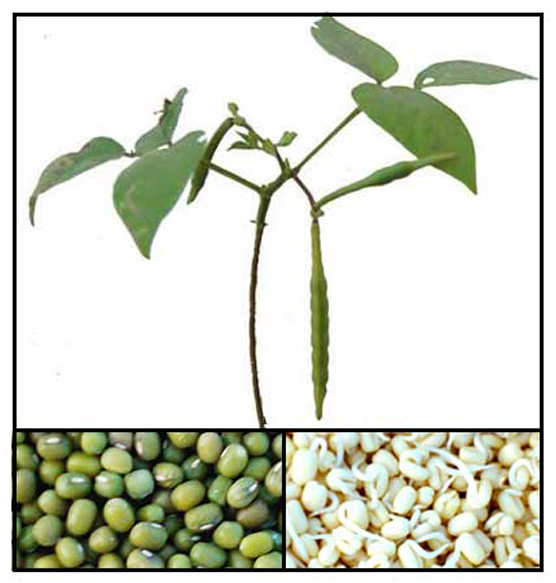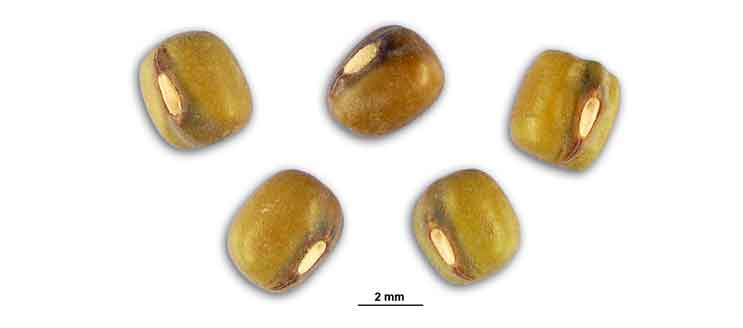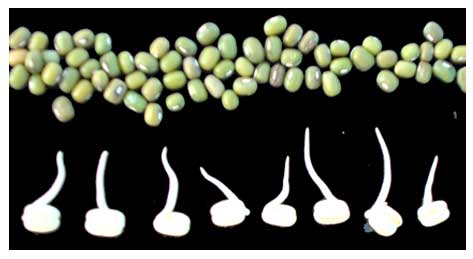|
 Botany Botany
Mungo is an erect, annual herb branching
at the base, more or less clothed with spreading, brownish hairs. Leaves are
long-petioled, compound, with three leaflets which are ovate and
entire, broad based with pointed tips, 8 to 15 centimeters long, the
lateral ones being inequilateral. Flowers are yellow, about 1 centimeter
long, arranged near the end of the short stalks. Pods are
linear, hairy, spreading, 6 to 8 centimeters long, about 6 millimeters wide, and covered with scattered, long, brownish hairs.
Seeds are 4 to 6 millimeters in length.
Distribution
- Cultivated throughout the Philippines.
- Not a native of the Archipelago.
- Scarcely naturalized.
- Also occurs in India to China and Malaya, in cultivation.
Constituents
- Seeds are high in carbohydrate (>45%)
and protein (>21%); fair source of calcium, iron, vitamins A and
B. deficient in vitamin C.
- Sprouts are a good source of vitamin B.
- Raw green gram contains trypsin inhibitor which is destroyed by cooking.
- Study of protein
isolate from green gram yielded protein 64.04%, total lipids 1.8%, total carbohydrate 27.64%, crude fiber 1.68%, and ash 4.84%. Water absorption was 2.26 g/g, oil absorption 1.24g/g, emulsion capacity 31.4g/g, and nitrogen solubility index 6.8 g/g. (11)
- Study isolated eight phytoalexins from Phaseolus aureus (mung bean) seedlings after treatment with aqueous CuCl2, viz., three isoflavones (genistein, 2′-hydroxygenistein and 2,3-dehydrokievitone), four isoflavanones (dalbergioidin, kievitone, cyclokievitone and 5-deoxykievitone) and the pterocarpan phaseollidin. (see study below) (12)
Properties
Seeds are considered tonic and aperient.

Uses
Culinary
- Extensively used in Philippine
cuisine, in salads or boiled, in soups or stews.
- In Chinese cooking, bean sprouts is considered a yin or cooling food.
Folkloric
- Decoction of seeds used as diuretic in cases of beriberi.
- The seeds, boiled or raw, used in maturative poultices.
- Extracts used for its protective and curative properties in polyneuritis galinarum.
- Roots considered narcotic, used for bone pains.
- In India, seeds are used, internally and externally, for paralysis, rheumatism and a variety
of nervous system ailments.
- Used for fevers.
- The seeds are used for coughs, hemorrhoids and liver afflictions.
- Powdered beans used to promote suppuration.
- Seeds used in anorexia.
- Poultice used for checking secretions of milk and reducing distention of the mammary glands.
- Powdered beans rubbed into scarifications over tumors and abscesses to promote suppuration.
- In Indo-China, seeds considered antiscorbutic and diuretic.
- In Chinese traditional medicine, mung bean soaked overnight with cold water is consumed as decoction or used with goat blood as antidote for arsenic poisoning.

Studies
• Hypotensive: The study showed all the extracts were hypotensive and contained bioactive
proteinaceous substances and stimulated urine flow. Combinations of
the extracts showed subtractive or additive effects. (1)
• Cardiovascular Effects: Previous studies have shown the hypotensive effect of green beans, common rue and kelp. In this study, green beans and kelp showed negative chronotropic effects, while rue showed positive chronotropic and inotropic effects. A combination of all three showed subtractive effects on the decrease of atrial rate. The three plants interacted to modify their various cardiovascular effects. (3)
• Hypolipidemic / Antiatherogenic: Changes
in serum lipids in normal and diabetic guinea pigs on feeding Phaseolus
aureus (Green gram): Study showed green gram feeding showed lowering of both free and esterified fractions of cholesterol, significant lowering of triglycerides and decreased
the total cholesterol / phospholipid ration indicating its antiatherogenic
nature. (4)
• Hypolipidemic: Hypercholesterolemic rats supplemented
with Isoflavones biochanin A and formononetin) from three pulses, including
P mungo, and p-coumaric acid showed hypolipidemic activity.
• Anti-Irritation Effects / Cosmetics / Vitexin / Isovitexin: Ethanolic extract isolated vitexin and isovitexin, previously suspected of antioxidant and anti-inflammatory activities. Study confirmed anti-irritation effects and suggests that the mung bean extract could be applied to cosmetic products. (5)
• Germination and Antioxidant Capacity: The study evaluated the effect of germination of raw mung beans and sprouts on antioxidant capacity and content of antioxidant compounds. Results showed germination of mung beans and soybean seeds is a good process for obtaining functional flours with greater antioxidant capacity and more antioxidant compounds than the raw legumes. (9)
• Antifungal / Phytoalexins: Study isolated eight phytoalexins. Study evaluated antifungal activity against Cladosporium cucumerinum. (see constituents above) (12)
• Antimicrobial: Study evaluated the antimicrobial activities in sprouts of mung beans (Vigna radiata).
Screening results revealed potential antibacterial and antifungal activities of mung bean extracts against 11 of 12 bacteria and a out of 10 fungi including antimicrobial activity against highly infectious MDR bugs. (13)
Availability
Wild and cultivated.
|


![]()

